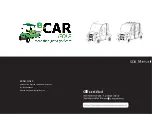
40
W
INCH
• Always inspect the winch cable before each use. Inspect for wear or kinks in the cable.
– A kinked winch cable made of wire rope is shown at right. Even after
being straightened out, this cable has been permanently and severely
damaged. Discontinue use of a cable in this condition.
– A winch cable made of synthetic rope should be inspected for signs of
fraying. Replace the cable if fraying is visible.
– Inspect the winch cable for fused or melted fibers, indicated by stiffness
and a smooth or glazed appearance. Discontinue use of a winch cable
in this condition.
SHOCK LOADING
The winch cable is designed and tested to withstand the loads produced by the winch motor when operated from a
stationary vehicle. The winch and winch cable are not designed for shock loading.
Practices that produce shock loading on a winch cable include:
• Abrupt acceleration of the vehicle against the pull of the winch cable, which causes immediate force on the winch
cable that exceeds the force the cable is designed to withstand.
• Jogging the winch by quickly turning the winch ON and OFF repeatedly, which puts extra load on the winch, winch
cable and generates excessive heat from the motor.
• Using the winch to tow vehicles or other objects.
A winch cable is not designed for shock loading. Shock loading can tension a cable
beyond its strength and cause it to break. A broken winch cable under high loading con
-
ditions can cause severe injury or death to anyone in the area.
When using the winch, use the following guidelines:
• To avoid generating high winch cable loads that may exceed the strength of the cable:
– Never use the winching vehicle to take up slack in the winch cable by moving the vehicle.
– Never use the winching vehicle to move the object being winched; use the winch only.
• Never jog the winch (quickly turn the winch ON and OFF repeatedly).
• Never tow a vehicle or other objects with a winch. Towing an object with a winch produces shock loading of the
cable even when towing at low speeds.Towing from a winch also positions the towing force high on the vehicle and
cause instability of the vehicle.
• Never use recovery straps with your winch. Recovery straps are designed to stretch, so they store energy. The
stored energy in the recovery strap will release if the winch cable breaks. The use of recovery straps can cause
severe injury or death.
• Never use the winch as a tie down to secure a vehicle to a trailer or other transportation vehicle. Using a winch as a
tie down can also cause shock loading that can damage the winch, winch cable or vehicles.
WINCH MAINTENANCE SAFETY
Improper or lack of maintenance and service could lead to severe injury or death. Always
follow all winch instructions and warnings in this manual.
• Always inspect the winch before each use. Inspect for worn or loose parts including mounting hardware. Never use
the winch if any part needs repair or replacement.
• Make sure the winch motor is cool before servicing the winch.
• Always disconnect the battery connections before working on your winch to prevent accidental activation of the
winch.
• For your safety, always replace winch parts, including the cable, with factory approved replacement parts.
• Replace the winch cable with one of the exact type.
Kinked
Bent
Stressed or Frayed
Summary of Contents for HAULER PRO 2022
Page 1: ...OWNER S MANUAL HAULER PRO 10002108 A ...
Page 12: ...10 INTRODUCTION ...
Page 22: ...20 SAFETY ...
Page 38: ...36 OPERATION ...
Page 58: ...56 MAINTENANCE LOG DATE MILES KM AND HOURS TECHNICIAN SERVICE PERFORMED COMMENTS ...
Page 59: ...MAINTENANCE LOG 57 DATE MILES KM AND HOURS TECHNICIAN SERVICE PERFORMED COMMENTS ...
Page 60: ...58 MAINTENANCE LOG DATE MILES KM AND HOURS TECHNICIAN SERVICE PERFORMED COMMENTS ...
Page 61: ...APPENDIX A A 1 APPENDIX A BATTERY CHARGER USER S GUIDE ...
Page 64: ...A 4 APPENDIX A ...
Page 65: ...APPENDIX A B 5 APPENDIX B BATTERY CHARGER USER S GUIDE ...
Page 68: ...B 8 APPENDIX B ...
Page 69: ...APPENDIX A C 9 APPENDIX C BATTERY CHARGER USER S GUIDE ...
































